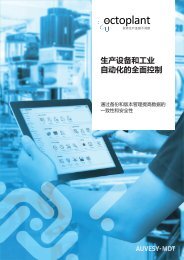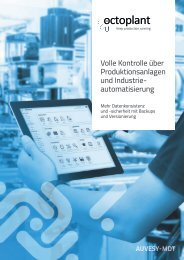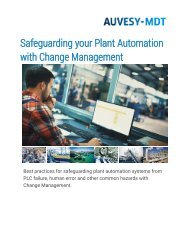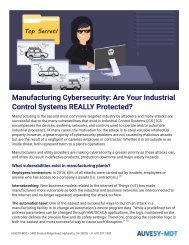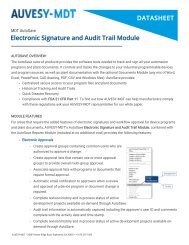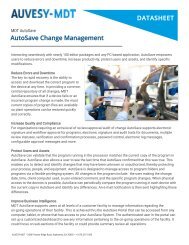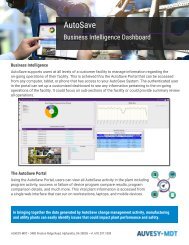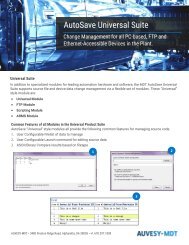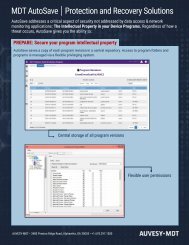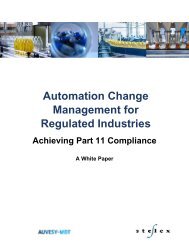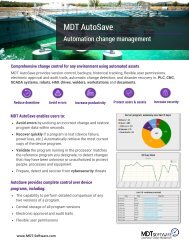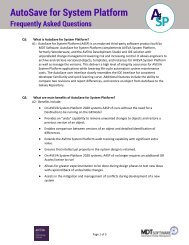White paper - Automation Change Management for Regulated Industries
Achieving Part 11 Compliance
Achieving Part 11 Compliance
- TAGS
- changemanagement
- autosave
Create successful ePaper yourself
Turn your PDF publications into a flip-book with our unique Google optimized e-Paper software.
<strong>Automation</strong> <strong>Change</strong><br />
<strong>Management</strong> <strong>for</strong><br />
<strong>Regulated</strong> <strong>Industries</strong><br />
Achieving Part 11 Compliance<br />
A <strong>White</strong> Paper
Synopsis<br />
This white<strong>paper</strong> provides in<strong>for</strong>mation related to FDA regulation 21 CFR Part 11<br />
(Part 11) <strong>for</strong> organizations considering AUVESY-MDT software solutions. The<br />
intent is to establish a mutual understanding of the rules set <strong>for</strong>th in Part 11 and<br />
explain how AutoSave can help their customers comply with the rules. This<br />
white<strong>paper</strong> was written by Stelex, Inc.<br />
Part 11 Review<br />
Part 11 establishes the criteria under which electronic records and electronic<br />
signatures are considered as equivalent to <strong>paper</strong> records and handwritten<br />
signatures executed on <strong>paper</strong>. The rule applies to records in electronic <strong>for</strong>m that<br />
are created, modified, maintained, archived, retrieved, or transmitted under any<br />
records requirements set <strong>for</strong>th in FDA regulations.<br />
In order <strong>for</strong> organizations to comply with Part 11, requirements of authenticity,<br />
integrity, and confidentiality of the records and signatures must be met. Any<br />
computer system utilizing electronic records and signatures must be validated<br />
according to generally accepted industry standards associated with a Software<br />
Development Life Cycle (SDLC) to ensure its accuracy, reliability, consistent<br />
intended per<strong>for</strong>mance, and ability to discern invalid or altered records.<br />
Several checks must be built into a Part 11 compliant system including:<br />
• System checks that en<strong>for</strong>ce the sequencing of events, where required<br />
• Authority checks that determine who has access to the system and at<br />
what level<br />
• Device checks that determine the validity of sources of data being entered<br />
into a system<br />
The system must also be able to independently generate audit trails that describe<br />
who accessed the system and what operations were per<strong>for</strong>med during any given<br />
period. The audit trails must be secured, computer-generated, time-stamped, not<br />
obscure previously recorded data, identify the person making the change,<br />
include original and changed data, and be available <strong>for</strong> review and copy by FDA.<br />
Audit trail documentation thus generated is required to be retained <strong>for</strong> a period at<br />
least as long as that required <strong>for</strong> the subject electronic records, either pursuant to<br />
a predicate rule or to the organization’s own records retention policy.<br />
Part 11 also sets <strong>for</strong>th requirements <strong>for</strong> electronic signatures. Each electronic<br />
signature used within an organization must be unique to an individual and not<br />
reused or assigned to another. The identity of the individual must be verified by<br />
2
the organization (e.g., via birth certificate, driver’s license, passport) be<strong>for</strong>e<br />
assigning the individual an electronic signature. The organization must also<br />
certify in writing to FDA that they intend to use their electronic signature as the<br />
legally binding equivalent of their handwritten signatures. This certification must<br />
be submitted to FDA in <strong>paper</strong> <strong>for</strong>m.<br />
Risk Assessment<br />
As a result of industry feedback, FDA modified its position on Part 11 in 2003.<br />
With streamlined en<strong>for</strong>cement and restricted interpretation by FDA, organizations<br />
must still comply with predicate rules regarding validation, audit trails, retention,<br />
copying, and legacy systems. The primary change in FDA guidance involves risk<br />
assessments per<strong>for</strong>med in each of these areas. The new emphasis upon a<br />
riskbased approach places the onus on industry to identify the risks and to<br />
determine appropriate actions.<br />
Organizations should have written procedures <strong>for</strong> identifying, specifying, and<br />
documenting the risk assessment techniques and risk mitigation methodologies<br />
to be used during the design and development of computer controlled systems.<br />
The intent is to detect potential design flaws (i.e., possibilities of failure that could<br />
cause harm to personnel, the subject system, or the environment) and to enable<br />
manufacturers to correct these failures be<strong>for</strong>e a product is commercially<br />
released.<br />
It is beneficial to first determine which requirements have potential risks<br />
associated with them. Then the potential risk and possible cause should be<br />
identified. As an example, risk severity, likelihood, and its ability to be detected<br />
can be quantified. Risk severity could be rated from negligible to high with<br />
associated sequential numbers and criteria <strong>for</strong> each. Risk likelihood could be<br />
rated from improbable to frequent and so <strong>for</strong>th. The results from these types of<br />
ratings can be used to calculate a risk index that would then be the basis of a risk<br />
mitigation plan.<br />
AUVESY-MDT Commitment to <strong>Regulated</strong> Industry<br />
Programmable Logic Controllers (PLCs) are the backbone of automated<br />
manufacturing in the pharmaceutical, biotechnology, and medical device<br />
industry. With AutoSave, AUVESY-MDT has a substantial history as a world<br />
leader in automation change management supporting the most comprehensive<br />
range of PLC devices and editors. These devices are programmable and rely on<br />
digital programs that define their functionality and operation. The programs are<br />
stored electronically in the device and on backup electronic media. For this<br />
reason they are considered electronic records and fall under the requirements<br />
imposed by 21 CFR Part 11. Methods <strong>for</strong> conventional office records tracking<br />
3
and change control would not be sufficient <strong>for</strong> records associated with<br />
programmable devices.<br />
It is not uncommon to find that PLCs are supplied by a variety of manufacturers<br />
where each brand comes with a unique set of program development and device<br />
management tools. Add to this the many legacy systems installed in an operating<br />
plant and one begins to understand the enormity of the change control and<br />
program archiving problem.<br />
The program files represent the result of hundreds of worker hours. If a device<br />
fails or a program is lost, the inability to restore the last known working version<br />
can result in substantial economic loss in the <strong>for</strong>m of production down-time.<br />
The AutoSave server stores all programs <strong>for</strong> access during crisis situations. The<br />
server is solely responsible <strong>for</strong> system security and privilege control, archiving<br />
versions and ancestors, managing program files, and creating audit trails <strong>for</strong><br />
historical tracking.<br />
For each PLC connected to the network, the AutoSave Server records:<br />
1. The type of device<br />
2. Where the device is located on the network<br />
3. The type of software that is used to program the device<br />
4. Who is authorized to access that device and the changes they are<br />
authorized to make.<br />
5. Previous copies or ancestors of the production copies. Multiple previous<br />
versions may be archived.<br />
6. Master copies or named versions of the programs<br />
When a user wishes to work with a specific PLC, AutoSave works with the client<br />
in the following sequence:<br />
1. Technician logs in and requests the right to work on the network by<br />
entering a user name and password.<br />
2. The AutoSave server reviews the user’s privileges and the AutoSave client<br />
displays the devices and programs the user is authorized to access. User<br />
requests a device and control program and AutoSave server grants<br />
access and downloads the required files. The files are marked at the<br />
server as being locked and checked-out. Requests by other clients to<br />
access those files will be denied.<br />
3. AutoSave client then starts the programming editor application required to<br />
work with the selected device and then connects to the offline or online<br />
PLC through the field network.<br />
4
4. The user then works offline or online with the selected PLC, making the<br />
required modifications.<br />
5. When complete, the changes can be optionally uploaded from the PLC to<br />
the client (if per<strong>for</strong>med online).<br />
6. The user then annotates the change record, including a mandatory record<br />
of the reason <strong>for</strong> the modification.<br />
7. Together with the modification record, the new copy of the program file is<br />
uploaded from the client to the server. The server automatically moves the<br />
previous version to the ancestor files and saves the new version as the<br />
current version. The server then writes the audit trail <strong>for</strong> the user’s<br />
session.<br />
8. The AutoSave server then sends an email to the individuals who need to<br />
be advised that a change was made. Typically these will be sent to<br />
responsible individuals in Engineering, Production, QC, and Validation.<br />
The reader will note that even remote laptops are controlled in the AutoSave<br />
change control environment. However, it is possible <strong>for</strong> a technically capable<br />
individual with a private copy of the manufacturer’s support software to get in and<br />
make an uncontrolled change. To protect against this, AutoSave Server<br />
periodically connects to each device through the enterprise and proprietary<br />
networks and checks the actual contents of the device against the copies stored<br />
on the server. If these are ever different, notifications go out immediately. Under<br />
the change control environment established by AutoSave, the following benefits<br />
are realized by the Part 11 regulated organization:<br />
All electronic files and program copies associated with Programmable Devices<br />
reside in one location, the AutoSave Server. Backup is controlled and automatic<br />
so any uncertainty of manual backups is eliminated.<br />
1. Access by any individual to the program files and the devices themselves<br />
is tightly controlled from one location, the AutoSave Server. Electronic<br />
signature protection in accordance with 21CFR Part11 can be provided.<br />
The user need not worry about establishing authorization through the<br />
different types of device support workstations needed to access multiple<br />
brands of PLCs. Prior authorization at the AutoSave server level is<br />
required <strong>for</strong> anyone to access this in<strong>for</strong>mation.<br />
2. The steps per<strong>for</strong>med during a user’s session on an AutoSave client<br />
workstation must be accomplished in a consistent and repeatable fashion.<br />
Activities resulting in saved files at the client must be annotated with the<br />
extent of the changes and the reasons <strong>for</strong> them. Also, changes must be<br />
per<strong>for</strong>med within the time window of the AutoSave client.<br />
3. All file storage and version archiving is per<strong>for</strong>med automatically in a tightly<br />
controlled environment. The proper audit trails are created transparently<br />
and human error cannot factor into the process.<br />
5
4. Audits can be conducted simply at any time. AutoSave has a<br />
comprehensive Web Reports application to allow change histories to be<br />
extracted from the system. For many of the more popular PLC’s,<br />
AutoSave will also annotate the PLC program documentation with the<br />
specific changes made, whether or not the technician making the change<br />
annotated the program. For users who want additional data, the Web<br />
Reports package provides additional comprehensive reports.<br />
5. When a change is made to a program, individuals who need to know are<br />
notified by email. The individual’s name, device name, time and date of<br />
the change, and the reason <strong>for</strong> the change are included in the email.<br />
6. Programmable device programs are automatically checked <strong>for</strong> integrity on<br />
a scheduled basis. Any deviation from the expected version will be flagged<br />
immediately and the proper individuals notified.<br />
7. If a disaster occurs, management is assured the program can be restored<br />
quickly and the version reloaded is identical to the previous one. Likewise,<br />
if a new version is faulty, restoration of the previous version is made<br />
quickly. Downtime is minimized and the potential <strong>for</strong> disaster is eliminated.<br />
8. The cost expended to develop a program, test, debug, and validate it<br />
cannot be lost and will not have to be duplicated. In essence the value of<br />
this intangible but expensive asset is assured.<br />
The following table is based on the requirements of Part 11 and the AutoSave<br />
application assessed <strong>for</strong> its applicability and level of compliance:<br />
Section # Requirement Compliance/Documentation/Comments<br />
AutoSave Software<br />
B/11.10<br />
Controls <strong>for</strong> closed systems.<br />
Persons who use closed systems to<br />
create, modify, maintain, or transmit<br />
electronic records shall employ<br />
procedures and controls designed to<br />
ensure the authenticity, integrity, and,<br />
when appropriate, the confidentiality of<br />
electronic records, and to ensure that<br />
the signer cannot readily repudiate the<br />
signed record as not genuine. Such<br />
procedures and controls shall include the<br />
following:<br />
6
(a)<br />
(b)<br />
Validation of systems to ensure<br />
accuracy, reliability, consistent intended<br />
per<strong>for</strong>mance, and the ability to discern<br />
invalid or altered records.<br />
NOTE: The FDA intends to exercise<br />
en<strong>for</strong>cement discretion regarding this<br />
requirement <strong>for</strong> Part 11, though persons<br />
must still comply with applicable<br />
predicate rule requirements <strong>for</strong> validation.<br />
The FDA recommends that validation be<br />
based on a justified and documented risk<br />
assessment.<br />
The ability to generate accurate and<br />
complete copies of records in both<br />
human readable and electronic <strong>for</strong>m<br />
suitable <strong>for</strong> inspection, review, and<br />
copying by the agency. Persons should<br />
contact the agency if there are any<br />
questions regarding the ability of the<br />
agency to per<strong>for</strong>m such review and<br />
copying of the electronic records.<br />
NOTE: The FDA intends to exercise<br />
en<strong>for</strong>cement discretion regarding this<br />
requirement <strong>for</strong> Part 11; persons should<br />
provide an investigator with reasonable<br />
and useful access to records during an<br />
inspection ensuring the copying process<br />
produces copies that preserve the content<br />
and meaning of the record.<br />
N/A<br />
Notes:<br />
Each client will have a unique approach to<br />
validation and are responsible <strong>for</strong> validating<br />
their individual AutoSave implementations.<br />
AUVESY-MDT can provide in<strong>for</strong>mation to<br />
assist in the ef<strong>for</strong>t.<br />
Internally, AutoSave has undergone<br />
rigorous testing governed by internal<br />
AUVESY-MDT testing protocols. As of<br />
AutoSave Version 5.03 there have been no<br />
Part 11 deviations per QA procedures.<br />
Reports generated using the AutoSave<br />
Software can be viewed on any connected<br />
Client PC and also when printed to a<br />
connected printer.<br />
7
Section # Requirement Compliance/Documentation/Comments<br />
AutoSave Software<br />
(c)<br />
(d)<br />
(e)<br />
(f)<br />
Protection of records to enable their<br />
accurate and ready retrieval throughout<br />
the records retention period.<br />
NOTE: The FDA intends to exercise<br />
en<strong>for</strong>cement discretion regarding this<br />
requirement <strong>for</strong> Part 11. The FDA<br />
suggests the decision on how to maintain<br />
records be based on predicate rule<br />
requirements and on a justified and<br />
documented risk assessment.<br />
Limiting system access to authorized<br />
individuals.<br />
Use of secure, computer-generated,<br />
time-stamped audit trails to<br />
independently record the date and time of<br />
operator entries and actions that create,<br />
modify, or delete electronic records.<br />
Record changes shall not obscure<br />
previously recorded in<strong>for</strong>mation. Such<br />
audit trail documentation shall be<br />
retained <strong>for</strong> a period at least as long as<br />
that required <strong>for</strong> the subject electronic<br />
records and shall be available <strong>for</strong> agency<br />
review and copying.<br />
NOTE: The FDA intends to exercise<br />
en<strong>for</strong>cement discretion regarding this<br />
requirement <strong>for</strong> Part 11, though persons<br />
must still comply with applicable<br />
predicate rule requirements related to<br />
documentation of, <strong>for</strong> example, date,<br />
time, or sequencing of events. FDA<br />
states even if no predicate rule exists <strong>for</strong><br />
this requirement, it may still be important<br />
to have audit trails or other security<br />
measure to ensure the trustworthiness<br />
and reliability of the records.<br />
Use of operational system checks to<br />
en<strong>for</strong>ce permitted sequencing of steps<br />
and events, as appropriate.<br />
Records are maintained in a secure<br />
relational database retrievable using a<br />
variety of database reporting tools. Record<br />
retention periods can be defined and<br />
configured based on standard business<br />
procedures.<br />
Access is limited to the list of users present<br />
in the User Administration menu of the<br />
interface. Users have privileges associated<br />
with their login in<strong>for</strong>mation making it<br />
possible to limit certain functions only to<br />
specific users.<br />
The system maintains an “Activity Log” that<br />
tracks the user actions and changes in<br />
program versions. Audit trails are stored in<br />
relational database tables. The persistent<br />
tables, LG_Sys and LG_Approval, log<br />
messages written by the system and those<br />
in support of Part 11 features respectively.<br />
All activities (per<strong>for</strong>med by the user or by<br />
the system) can be accessed/ viewed<br />
through a set of reports present in the<br />
Reporting Module of the application. Audit<br />
Trails cannot be bypassed or disabled by<br />
users.<br />
Steps are en<strong>for</strong>ced with respect to checking<br />
in and checking out programs and also with<br />
creating ancestor versions of programs<br />
stored within the AutoSave database.<br />
8
Section # Requirement Compliance/Documentation/Comments<br />
AutoSave Software<br />
(g)<br />
Use of authority checks to ensure that<br />
only authorized individuals can use the<br />
system, electronically sign a record,<br />
access the operation or computer system<br />
input or output device, alter a record, or<br />
per<strong>for</strong>m the operation at hand.<br />
Access is limited to the list of users present<br />
in the User Administration menu of the<br />
interface. Users have privileges associated<br />
with their login in<strong>for</strong>mation making it<br />
possible to limit certain functions only to<br />
specific users.<br />
(h)<br />
(i)<br />
(j)<br />
Use of device (e.g., terminal) checks to<br />
determine, as appropriate, the validity of<br />
the source of data input or operational<br />
instruction.<br />
Determination that persons who develop,<br />
maintain, or use electronic<br />
record/electronic signature systems has<br />
the education, training, and experience<br />
to per<strong>for</strong>m their assigned tasks.<br />
The establishment of, and adherence<br />
to, written policies that hold individuals<br />
accountable and responsible <strong>for</strong> actions<br />
initiated under their electronic signatures,<br />
in order to deter record and signature<br />
falsification.<br />
The list of devices connected to the<br />
AutoSave server needs to be configured<br />
upon install and data is transferred between<br />
the server/ client PC and the device only <strong>for</strong><br />
the specified devices. Each device is<br />
assigned a unique IP address thus ensuring<br />
the validity of the data transfer between the<br />
device and the software.<br />
Training on use and maintenance is<br />
available from AUVESY-MDT. Training in<br />
application and operator training is also<br />
available.<br />
N/A<br />
Customers are responsible <strong>for</strong> developing<br />
policies and procedures that hold individuals<br />
accountable and responsible <strong>for</strong> actions<br />
initiated under their electronic signature.<br />
(k)<br />
(1)<br />
Use of appropriate controls over systems<br />
documentation including:<br />
Adequate controls over the distribution<br />
of, access to, and use of documentation<br />
<strong>for</strong> system operation<br />
and maintenance.<br />
(2) Revision and change control<br />
procedures to maintain an audit trail that<br />
documents time-sequenced development<br />
and modification of systems<br />
documentation.<br />
The client is responsible <strong>for</strong> this procedural<br />
control as it pertains to documentation that<br />
can be modified by the client. The client<br />
cannot modify AUVESY-MDT copyrighted<br />
material.<br />
Client developed and/or modified electronic<br />
documentation must follow approved<br />
change control procedures that include<br />
audit trail in<strong>for</strong>mation per Part 11. This<br />
does not pertain to AUVESY-MDT<br />
copyrighted material.<br />
9
Section # Requirement Compliance/Documentation/Comments<br />
AutoSave Software<br />
B/11.30<br />
B/11.50<br />
(a)<br />
Controls <strong>for</strong> open systems<br />
Persons who use open systems to<br />
create, modify, maintain, or transmit<br />
electronic records shall employ<br />
procedures and controls designed to<br />
ensure the authenticity, integrity, and, as<br />
appropriate, the confidentiality of<br />
electronic records from the point of their<br />
creation to the point of their receipt. Such<br />
procedures and controls shall include<br />
those identified in § 11.10, as<br />
appropriate, and additional measures<br />
such as document encryption and use of<br />
appropriate digital signature standards to<br />
ensure, as necessary under the<br />
circumstances, record authenticity,<br />
integrity, and confidentiality.<br />
Signature manifestations<br />
Signed electronic records shall contain<br />
in<strong>for</strong>mation associated with the signing<br />
that clearly indicates all of the following:<br />
(1) The printed name of the signer<br />
(2)<br />
(3)<br />
(b)<br />
The date and time when the signature<br />
was executed; and<br />
The meaning (such as review, approval,<br />
responsibility, or authorship) associated<br />
with the signature.<br />
The items identified in paragraphs (a)(1),<br />
(a)(2), and (a)(3) of this section shall be<br />
subject to the same controls as <strong>for</strong><br />
electronic records and shall be included<br />
as part of any human readable <strong>for</strong>m of the<br />
electronic record (such as electronic<br />
display or printout).<br />
N/A<br />
The Activity Log contains the User ID<br />
associated with each event/action.<br />
The Activity Log contains a date/time stamp<br />
associated with each event/action.<br />
The Activity Log contains the details of the<br />
events/ actions per<strong>for</strong>med (approval,<br />
responsibility, authorship).<br />
The Activity Log contains the User ID/time<br />
stamp and the details of the action<br />
per<strong>for</strong>med associated with each<br />
event/action.<br />
10
Section # Requirement Compliance/Documentation/Comments<br />
AutoSave Software<br />
B/11.70<br />
C/11.100<br />
(a)<br />
Signature/record linking<br />
Electronic signatures and handwritten<br />
signatures executed to electronic records<br />
shall be linked to their respective<br />
electronic records to ensure that the<br />
signatures cannot be excised, copied, or<br />
otherwise transferred to falsify an<br />
electronic record by ordinary means.<br />
General requirements<br />
Each electronic signature shall be<br />
unique to one individual and shall not be<br />
reused by, or reassigned to, anyone else.<br />
(b) Be<strong>for</strong>e an organization establishes,<br />
assigns, certifies, or otherwise sanctions<br />
an individual’s electronic signature, or<br />
any element of such electronic signature,<br />
the organization shall verify the identity<br />
of the individual.<br />
(c)<br />
Persons using electronic signatures shall,<br />
prior to or at the time of such use,<br />
certify to the agency that the electronic<br />
signatures in their system, used on or after<br />
August 20, 1997, are intended to be the<br />
legally binding equivalent of traditional<br />
handwritten signatures.<br />
(1) The certification shall be submitted in<br />
<strong>paper</strong> <strong>for</strong>m and signed with a traditional<br />
handwritten signature, to the Office of<br />
Regional Operations (HFC–100), 5600<br />
Fishers Lane, Rockville, MD 20857.<br />
(2) Persons using electronic signatures shall,<br />
upon agency request, provide<br />
additional certification or testimony<br />
that a specific electronic signature is the<br />
legally binding equivalent of the signer’s<br />
handwritten signature.<br />
Each User ID has a unique password<br />
associated with it ensuring that the<br />
signatures cannot be excised, copied or<br />
transferred to falsify an electronic record.<br />
System access is based on unique User ID/<br />
password combinations. Customers should<br />
ensure procedures are in place to prevent<br />
reuse and/or reassignment of User ID’s.<br />
N/A<br />
Customers are responsible <strong>for</strong> the<br />
verification of the identity of the individual<br />
be<strong>for</strong>e an electronic signature is assigned<br />
and/or sanctioned.<br />
N/A<br />
Customers are responsible <strong>for</strong> certification<br />
to FDA that the electronic signatures used<br />
at their establishment are intended to be<br />
the legally binding equivalent of<br />
handwritten signatures.<br />
N/A<br />
Customers are responsible <strong>for</strong> the<br />
submission of the certification to FDA with<br />
a traditional handwritten signature.<br />
N/A<br />
Customers are responsible <strong>for</strong> providing<br />
certification or testimony that an individual’s<br />
electronic signature used at their<br />
establishment is the legally binding<br />
equivalent of their handwritten signature.<br />
11
Section # Requirement Compliance/Documentation/Comments<br />
AutoSave Software<br />
C/11.200<br />
(a)<br />
(i)<br />
(ii)<br />
Electronic signature components and<br />
controls<br />
Electronic signatures that are not<br />
based upon biometrics shall:<br />
(1) Employ at least two distinct<br />
identification components such as an<br />
identification code and password.<br />
When an individual executes a series of<br />
signings during a single, continuous<br />
period of controlled system access, the<br />
first signing shall be executed using all<br />
electronic signature components;<br />
subsequent signings shall be executed<br />
using at least one electronic signature<br />
component that is only executable by, and<br />
designed to be used only by, the<br />
individual.<br />
When an individual executes one or more<br />
signings not per<strong>for</strong>med during a single,<br />
continuous period of con-trolled system<br />
access, each signing shall be executed<br />
using all of the electronic signature<br />
components.<br />
(2) Be used only by their genuine owners.<br />
(3) Be administered and executed to ensure<br />
that attempted use of an individual’s<br />
electronic signature by anyone other<br />
than its genuine owner requires<br />
collaboration of two or more individuals.<br />
(b)<br />
Electronic signatures based upon<br />
biometrics shall be designed to ensure<br />
that they cannot be used by anyone other<br />
than their genuine owners.<br />
Each User ID has a unique password<br />
associated with it ensuring that the<br />
electronic signature has two distinct<br />
identification components.<br />
The User ID and password are required to<br />
login and also to per<strong>for</strong>m subsequent<br />
actions ensuring that at least one electronic<br />
signature component is required by an<br />
individual executing an electronic signature<br />
at any given time of use.<br />
The User ID and password are required to<br />
login and also to per<strong>for</strong>m subsequent<br />
actions ensuring that at least one electronic<br />
signature component is required by an<br />
individual executing an electronic signature<br />
at any given time of use.<br />
System access is granted based on a<br />
unique combination of User ID and<br />
password issued to only authorized users.<br />
System access is granted based on the<br />
unique combination of the User ID and<br />
password ensuring that the use of an<br />
electronic signature by anyone other that its<br />
genuine owner will require the collaboration<br />
of two or more individuals.<br />
N/A<br />
No biometrics used.<br />
12
Section # Requirement Compliance/Documentation/Comments<br />
AutoSave Software<br />
C/11.300<br />
Controls <strong>for</strong> identification<br />
codes/passwords<br />
(a)<br />
(b)<br />
(c)<br />
Persons who use electronic signatures<br />
based upon use of identification codes in<br />
combination with passwords shall<br />
employ controls to ensure their security<br />
and integrity. Such controls shall include:<br />
Maintaining the uniqueness of each<br />
combined identification code and<br />
password, such that no two individuals<br />
have the same combination of<br />
identification code and password.<br />
Ensuring that identification code and<br />
password issuances are periodically<br />
checked, recalled, or revised (e.g., to<br />
cover such events as password aging).<br />
Following loss management<br />
procedures to electronically de-authorize<br />
lost, stolen, missing, or otherwise<br />
potentially compromised tokens, cards,<br />
and other devices that bear or generate<br />
identification code or password<br />
in<strong>for</strong>mation, and to issue temporary or<br />
permanent replacements using suitable,<br />
rigorous controls.<br />
(d) Use of transaction safeguards to<br />
prevent unauthorized use of passwords<br />
and/or identification codes, and to detect<br />
and report in an immediate and urgent<br />
manner any attempts at their unauthorized<br />
use to the system security unit, and, as<br />
appropriate, to organizational<br />
management.<br />
The User ID and password combination<br />
allows the user to access the application<br />
based on the privileges associated with the<br />
User ID ensuring that no two individuals<br />
have the same set of credentials to gain<br />
access to the system.<br />
Customers are advised to implement<br />
procedures to periodically check, recall and<br />
revise the passwords issuances and to use<br />
the built in features of Windows Active<br />
Directory <strong>for</strong> password aging and history<br />
control.<br />
N/A<br />
Token cards or other devices that generate<br />
identification code or password in<strong>for</strong>mation<br />
are not currently used.<br />
Customers are advised to use the in-built<br />
features of Windows Active Directory to<br />
implement transaction safeguards to ensure<br />
that there is no unauthorized use of<br />
passwords and User IDs. Windows Active<br />
Directory will also allow system<br />
administrators to be notified, in an<br />
immediate manner, of any attempts of<br />
unauthorized use. It is further recommended<br />
that procedures be put in place <strong>for</strong> regular<br />
inspection of the operating system event log<br />
to detect such attempts.<br />
13
Section # Requirement Compliance/Documentation/Comments<br />
AutoSave Software<br />
(e)<br />
Initial and periodic testing of devices,<br />
such as tokens or cards, that bear or<br />
generate identification code or password<br />
in<strong>for</strong>mation to ensure that they function<br />
properly and have not been altered in an<br />
unauthorized manner.<br />
N/A<br />
Token cards or other devices that generate<br />
identification code or password in<strong>for</strong>mation<br />
are not currently used.<br />
14
About AUVESY-MDT<br />
AUVESY-MDT develops software to provide disaster recovery, version control, change<br />
detection and management <strong>for</strong> smart production machinery and other devices, used in<br />
the manufacturing and industrial sectors. AUVESY-MDT solutions back up key machine<br />
programming and produce intuitive documentation of changes, simplifying maintenance<br />
and aiding in plant optimization. Downtime is significantly reduced, due to easy and<br />
reliable code management, trouble shooting and disaster recovery.<br />
www.AUVESY-MDT.com<br />
678.297.1000<br />
About Stelex<br />
Stelex provides enterprise-wide compliance solutions to regulated industries in the<br />
pharmaceutical, medical device, diagnostic and biotechnology sectors. The firm delivers<br />
a comprehensive suite of validation, technology, regulatory and business solutions. In<br />
addition to quality auditing services, Stelex offers Sarbanes-Oxley Compliance<br />
consulting, System Integration and Implementation, Security & PKI services, Computer<br />
System Validation, Process Validation, Equipment Qualification, Infrastructure<br />
Qualification, Program <strong>Management</strong>, Best Practice Consulting, and a broad range of<br />
technical training and professional education through fully accredited Stelex University.<br />
Stelex’s corporate office is located in Bensalem, PA, with regional offices in Puerto Rico,<br />
Massachusetts, New Jersey and Illinois. Since 1986, Stelex has built its reputation on<br />
the long-term relationships established with both its clients and partners. Stelex is<br />
positioned to be your total compliance solutions provider.<br />
www.stelex.com<br />
215.638.9700<br />
About the Author<br />
Stephen Dallas is a Project Manager at Stelex in the Pennsylvania office where he has<br />
managed long-term Quality <strong>Management</strong> and Compliance Assessment projects <strong>for</strong><br />
major pharmaceutical companies. He has also helped Stelex establish strategic<br />
partnerships with companies who supply various industries with enterprise solutions.<br />
15



